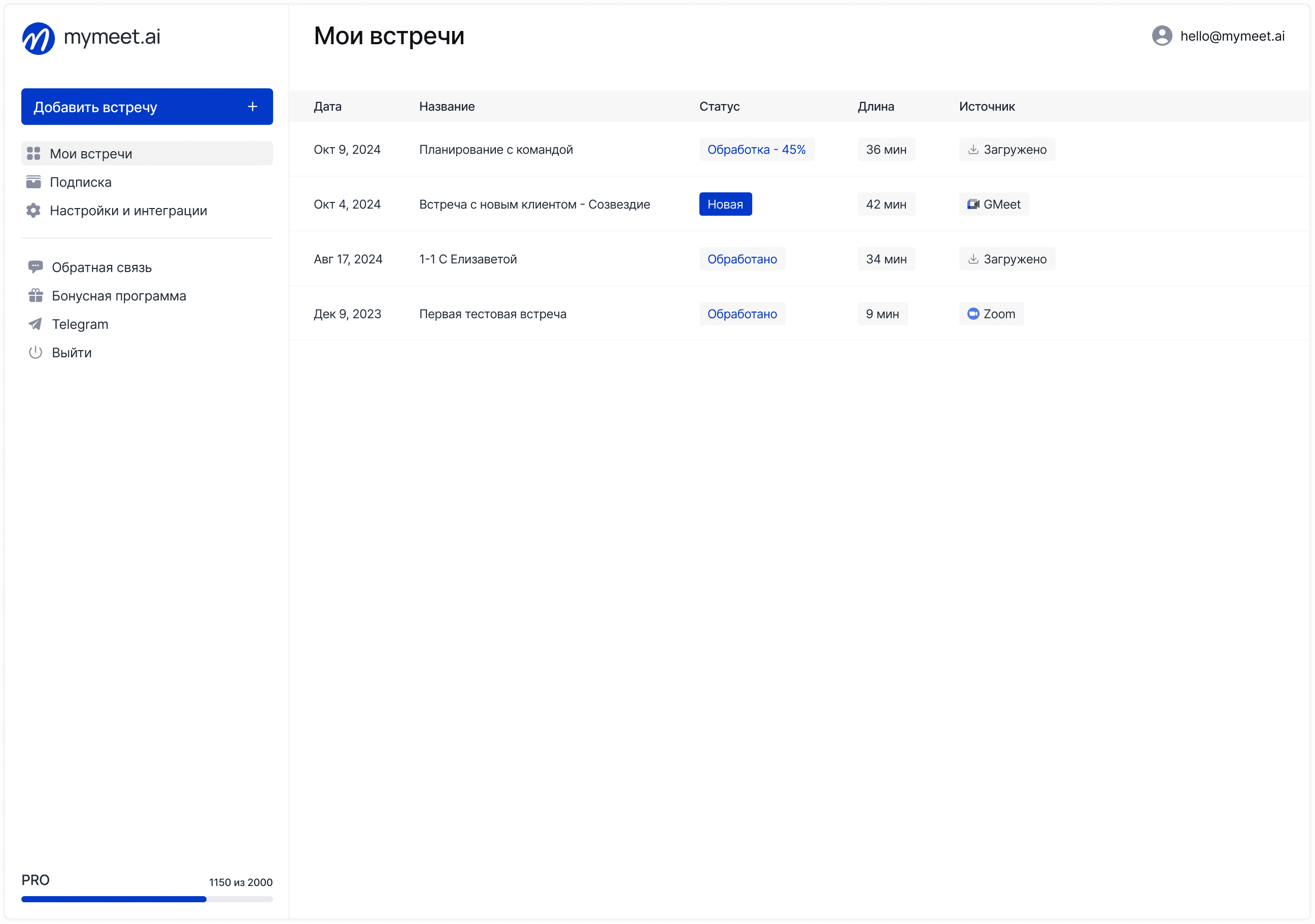Technology & AI

Fedor Zhilkin
Sep 16, 2025
Over 300 million users daily choose between Zoom and Microsoft Teams for business video conferencing, but 70% make decisions unconsciously — simply using what's available in their company. Yet the wrong choice can cost organizations hundreds of thousands of rubles annually due to overpaying for unnecessary features or productivity losses from inconvenient interfaces.
Hello! The mymeet.ai team tested both platforms in real corporate conditions and compiled an honest Zoom vs Teams comparison. We'll show objective advantages and disadvantages of each solution so you can make an informed decision for your team.
Zoom or Microsoft Teams: What's Better to Choose
Zoom and Microsoft Teams represent two different approaches to corporate communications — specialized video conferencing versus comprehensive work platform.
What's the Difference Between Zoom and Teams
Understanding each platform's basic philosophy helps determine which better suits your tasks.
Zoom — video conferencing master.

Platform created exclusively for video communication and does it better than anyone. Every feature is optimized for quality meetings: connection stability, simple joining, rich interaction capabilities during calls.
Microsoft Teams — work ecosystem.

Teams is part of the large Microsoft 365 ecosystem and solves tasks beyond video calls: permanent team channels, collaborative document work, corporate process integration.
Who Zoom and Teams Are Created For
Each platform was originally created for different user types and usage scenarios.
Zoom oriented toward: companies of any size conducting many important meetings with external participants, international teams, organizations with high video communication quality requirements.
Teams oriented toward: corporations already using Microsoft 365, teams with intensive internal collaboration, organizations needing unified platforms for all communications.
Zoom vs Teams: Feature and Capability Comparison
Detailed comparison of main capabilities helps understand which platform better handles your tasks.
Zoom vs Teams Video Quality
This is a fundamental criterion for any video conferencing platform.
Zoom: Industry-best video and audio quality. Automatic adaptation to internet speed, excellent performance with weak connection. HD support for all participants, professional noise suppression.
Teams: Good quality but may lag behind Zoom with unstable internet. Sometimes delays occur with large participant numbers. HD video available but optimization less advanced.
Winner: Zoom — exceeds in stability and connection quality.
What's Simpler to Use — Zoom or Teams
How easily new users can start working with the platform.
Zoom: Intuitively clear interface learned in 5 minutes. Minimum buttons, logical function placement. External participants connect without registration with one click.
Teams: More complex interface due to multiple functions. New users need time to understand channels, chats, and files. External participants may need app installation.
Winner: Zoom — significantly simpler to learn and use.
Meeting Functionality: Zoom vs Microsoft Teams
Comparison of specific capabilities for conducting effective meetings.
Zoom: Breakout rooms, interactive whiteboard, polls, reactions, screen annotations, waiting room, local and cloud recording.
Teams: Breakout rooms, interactive whiteboard, real-time Office document collaboration, task planner integration.
Winner: Tie — different strengths for different tasks.
Collaboration in Zoom and Teams
Capabilities for team work beyond video calls.
Zoom: Basic chat during meetings, file sharing. Main focus on video conferencing quality, not permanent communication.
Teams: Permanent team channels, structured conversations, collaborative document editing, SharePoint integration, project planner.
Winner: Teams — created for comprehensive collaboration.
Zoom vs Teams Pricing: What's Cheaper
The financial aspect often becomes a decisive factor when choosing a corporate platform.
How Much Zoom and Teams Cost
Both platforms use different pricing models affecting total expenses.
Zoom:
Basic: Free (40-minute limit for groups)
Pro: $14.99/month per user
Business: $19.99/month per user
Enterprise: from $19.99/month per user
Teams:
Included in Microsoft 365 Business Basic from 360₽/month
Separate Teams Essentials: $4/month per user
Full functionality within Microsoft 365
Real Cost Zoom vs Teams
For 20-person team over 3 years:
Zoom Business: $19.99 × 20 × 36 months = $14,392 (≈1,150,000₽)
Microsoft 365 Business Standard: $12.50 × 20 × 36 months = $9,000 (≈720,000₽) + full Office
Verdict: Teams more profitable when purchased with Microsoft 365, especially if Office is needed.
Zoom vs Teams: Detailed Comparison Table
Direct comparison of key characteristics helps quickly assess which platform better suits your tasks. Each criterion is objectively evaluated based on real testing.
Criterion | Zoom | Microsoft Teams | Winner |
Video Quality | Excellent, adapts to weak internet | Good, can be unstable | 🏆 Zoom |
Ease of Use | Very simple, 5-minute learning | More complex, many functions | 🏆 Zoom |
Meeting Features | Breakout rooms, whiteboard, polls | Breakout rooms, Office collaboration | Tie |
Cost | $14.99-19.99/month | 360₽/month + Office | 🏆 Teams |
External Meetings | One-click connection | Requires app/account | 🏆 Zoom |
Collaboration | Basic chat, files | Team channels, Office integration | 🏆 Teams |
Integrations | 2000+ applications | Deep Microsoft ecosystem | Tie |
Security | End-to-end encryption, waiting rooms | Azure AD, corporate policies | Tie |
Mobile Devices | Excellent apps | Good apps | 🏆 Zoom |
Support | Fast but paid | Corporate through Microsoft | 🏆 Teams |
Overall Score: Zoom — 4 wins, Teams — 3 wins, 3 ties
Zoom wins in video communication quality and ease of use. Teams better for comprehensive corporate work and Office integration.
Zoom vs Microsoft Teams Integrations
Ability to connect to existing work tools critically important for corporate use.
Zoom Integrations: Quantity and Capabilities
Zoom offers 2000+ integrations through its proprietary app store.
Popular integrations: Salesforce, HubSpot, Slack, Trello, Google Calendar, Outlook, most CRM systems.
Advantages: Works with virtually any tools, simple integration setup, active developer ecosystem.
Teams Integrations with Microsoft and Other Services
Teams deeply integrated with Microsoft products and have limited external integrations.
Built-in integrations: Office 365, SharePoint, OneDrive, Power Platform, Outlook, Exchange, Azure.
Advantages: Seamless Office document work, single sign-on, centralized management, deep integration.
Winner: Zoom for diverse integrations, Teams for depth of Microsoft product work.
Zoom vs Teams Security: What's More Reliable
Corporate security becomes increasingly critical for video conferencing platform choice.
Zoom Security: Protection Features
After 2020 problems, Zoom dramatically strengthened protection systems.
Security features: End-to-end encryption, waiting rooms, meeting passwords, recording control, SOC 2, HIPAA, GDPR compliance.
Management: Detailed administrator settings, security policies, user action auditing.
Teams Security: Microsoft Corporate Protection
Teams use Microsoft corporate security infrastructure.
Security features: Azure Active Directory, conditional access, information protection, industry standard compliance.
Management: Centralized management through Microsoft 365 Admin Center, organization-wide policies.
Verdict: Both solutions provide a high security level, and teams have advantages in corporate management.
Mymeet.ai: Meeting Analysis for Zoom and Teams

Regardless of choice between Zoom and Teams, most companies face the same problem — how to extract maximum benefit from conducted meetings. Mymeet.ai solves this task for both platforms.

✅ Zoom and Teams support — automatic connection and meeting recording on either platform
✅ Unified analytics — meeting effectiveness comparison regardless of platform used
✅ Automatic protocols — structured reports with decisions and tasks

✅ Work tool integration — synchronization with CRM, project systems
✅ Meeting search — ability to find any discussion or decision from past calls

✅ Comparative analytics — different platform usage metrics for choice optimization
Case: IT Company Chooses Between Zoom and Teams
A Moscow IT company (65 developers) tested Zoom and Teams to replace outdated Skype. Teams won due to Azure DevOps and GitHub integration, but Zoom used it for important client presentations. Task — analyze meeting effectiveness on different platforms.
Mymeet.ai implementation results:
Comparative effectiveness analysis of internal Teams vs client Zoom meetings
Automatic sprint planning and retrospective protocols in Teams
Detailed client presentation reports in Zoom with feedback capture
Unified knowledge base from all meetings regardless of platform
Decision-making time metrics for process optimization
Result: optimized use of each platform for specific scenarios, 12 hours weekly savings on meeting analysis.
Get maximum from any video conferencing platform. Contact consultant through form to configure meeting analysis in Zoom or Teams.

When to Choose Zoom
Zoom will be the best choice for certain organization types and usage scenarios.
Zoom Better Than Teams for Which Companies
Companies with frequent external meetings. Zoom excels in simple client, partner, contractor connection. Participants can join with one click without registration.
International teams. Better stability with a weak internet is critical for teams in different countries with varying connection quality.
Organizations outside Microsoft ecosystem. If the team uses Google Workspace, Slack, or other non-Microsoft tools, Zoom integrates better.
Maximum video quality requirements. For companies where video communication quality is critical — consulting, sales, training.
Business Types for Choosing Zoom
Consulting agencies with frequent client presentations
EdTech companies with online courses and webinars
International startups with distributed teams
Agencies with creative client presentations
When to Choose Microsoft Teams
Teams optimal for companies with certain corporate structure and needs.
Teams Better Than Zoom for Which Organizations
Organizations on Microsoft 365. If a company already uses Office, SharePoint, Exchange — Teams provides seamless integration and additional value without extra cost.
Teams with intensive collaboration. Permanent channels, collaborative document editing, structured project discussions.
Large corporations with developed IT infrastructure. Centralized user management, security policies, Active Directory integration.
Mixed communications. When I need not only video calls but chats, file sharing, task planning in one platform.
Company Types for Choosing Teams
Large corporations with traditional IT infrastructure
Banks and financial organizations with strict management requirements
Manufacturing companies with developed internal collaboration
Government organizations with centralized control needs
Transitioning Between Zoom and Teams
Switching from one platform to another requires planning to minimize work process disruption.
How to Switch from Teams to Zoom
Main challenges: Loss of Office document integration, need to configure new integrations, retrain users to simple interface.
Action plan: Export important chats and files, configure Zoom integrations with existing systems, train team on advanced Zoom features.
How to Switch from Zoom to Teams
Main challenges: More complex interface, need for Microsoft 365 licenses, communication process restructuring.
Action plan: Obtain Microsoft 365 licenses, create team and channel structure, train users on Microsoft ecosystem.
Conclusion: Zoom vs Teams — Make Choice Consciously
Zoom and Microsoft Teams are two excellent solutions for different usage scenarios. Zoom excels as a specialized video conferencing platform with maximum quality and simplicity. Teams better as a comprehensive work platform for teams already in the Microsoft ecosystem.
Don't choose a platform only by popularity or cost. Evaluate your real needs: how often you conduct external meetings, whether you use Microsoft 365, how important video communication quality is. The right choice will increase team productivity and save money.
Ready to make an informed choice between Zoom and Teams? Test both platforms in real work scenarios and choose a solution that better matches your business processes.
FAQ: Zoom vs Microsoft Teams
What's better for business — Zoom or Teams?
Zoom better for companies with frequent external meetings, maximum video quality requirements, using non-Microsoft tools. Teams better for corporations on Microsoft 365, teams with intensive internal collaboration, organizations with centralized IT management.
Zoom vs Teams — price comparison?
Zoom Pro $14.99/month, Business $19.99/month. Teams included in Microsoft 365 from 360₽/month + full Office package. Teams are more profitable when purchasing with Office, Zoom cheaper as a separate video conferencing solution.
Video quality — Zoom or Teams better?
Zoom exceeds video quality and connection stability. Works better with weak internet, supports HD for all participants, has more advanced noise suppression. Teams are good but may lag with unstable connections.
Zoom vs Teams for international teams?
Zoom better for international teams — excellent stability with different internet quality, simple connection without registration, better optimization for weak connections. Teams may experience problems with intercontinental calls.
Integrations — where more capabilities Zoom or Teams?
Zoom offers 2000+ integrations with any tools through the app store. Teams has deep Microsoft product integration but limited external integrations. Zoom for diversity, Teams for Microsoft ecosystem depth.
Zoom vs Team security for corporations?
Both provide high security. Zoom: end-to-end encryption, waiting rooms, detailed administrator settings. Teams: Azure AD, conditional access, centralized policies. Teams have advantages in corporate security management.
Ease of use — Zoom or Teams?
Zoom significantly simpler — intuitive interface, 5-minute learning, minimum buttons. Teams are more complex due to multiple functions, new users need time to study channels and interface. Zoom for simplicity, Teams for functionality.
Zoom vs Teams for training and webinars?
Zoom better for training — specialized webinar functions, breakout rooms, polls, simple student connection. Teams suitable for corporate training with integration in Microsoft learning management systems.
Can you use Zoom and Teams simultaneously?
Yes, many companies use both platforms: Teams for internal communications and collaboration, Zoom for external meetings and client presentations. Main thing — clearly separate usage scenarios and train team.
Zoom vs Teams for small business — what to choose?
For small businesses without Microsoft 365 — Zoom simpler and cheaper ($14.99/month). If Office needed — Teams in Microsoft 365 more profitable (360₽/month + Word, Excel, PowerPoint). Zoom for video conferencing focus, Teams for comprehensive work.
Fedor Zhilkin
Sep 16, 2025








